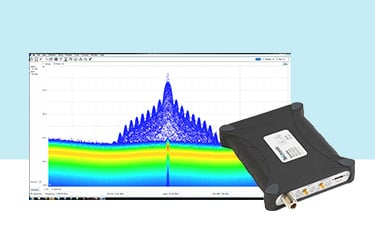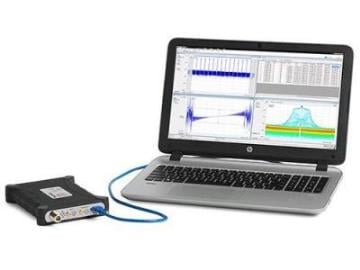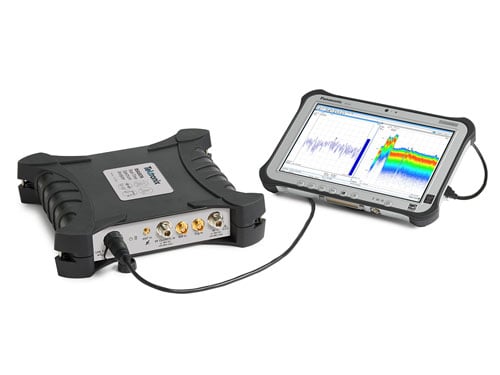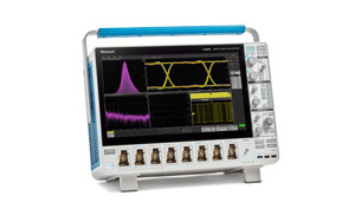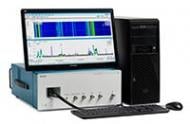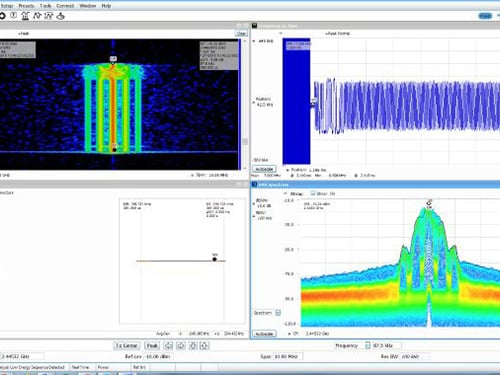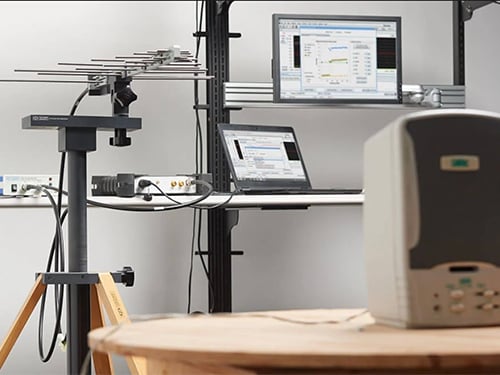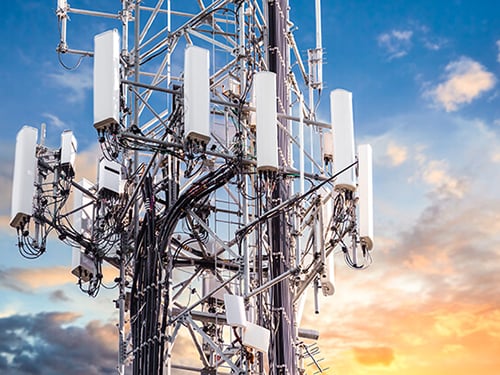お問い合わせ
ダウンロード
マニュアル、データシート、ソフトウェアなどのダウンロード:
フィードバック
無線周波数テストの理解:無線システムの成功の鍵
無線周波数(RF)テストとは、無線通信や放送からレーダや衛星システムに至るまで、さまざまな用途で信号伝送に使用される電磁波を測定・分析するプロセスです。RFテストでは、これらの信号の性能、強度、品質を評価し、特定の規格や要件を満たしていることを確認します。RFテストは、RFコンポーネントやシステムの開発、検証、保守に不可欠であり、無線通信やセンシング・システムの機能性や信頼性に影響を及ぼす可能性のある問題を特定するのに役立ちます。さらに、RFテストは、電磁適合性(EMC)(エミッションと干渉に対するイミュニティの両方をカバー)を保証します。これは、干渉を防止し、電子機器がその環境に調和して動作することを保証するために極めて重要です。
詳細をご覧ください。
RFテストとは
無線通信システムや電子機器の最適な性能と信頼性を確保するには、RFテストが不可欠です。包括的なRFテストを実施することで、エンジニアはシグナル・インテグリティ、干渉、およびシステム全体の効率に関連する問題を検出して解決できます。これにより、無線コンポーネントとシステムの品質と機能が向上するだけでなく、業界標準や規制要件への準拠も保証されます。効果的なRFテストは、コストのかかる障害のリスクを最小限に抑え、運用効率を最大化し、ワイヤレス・テクノロジが実際の状況で期待どおりに動作することを確信できます。究極的には、日常の家電製品から特殊な産業用機器に至るまで、無線周波数に依存するデバイスの開発、認証、保守にはRFテストが不可欠であり、企業が今日のハイパー・コネクテッドな世界で競争力を獲得するのに役立ちます。
周波数(スペクトル)と時間領域分析
周波数(スペクトラム)解析と時間領域解析の違いと共通点を理解することは、効果的な無線周波数(RF)テストにおいて極めて重要です。各ドメインは独自の情報を提供し、規制された周波数割り当ての範囲内で無線通信が適切に機能するように、最適化および保証するために使用されます。
周波数(スペクトル)領域分析
定義:周波数(スペクトラム)分析は、電磁信号の周波数スペクトラムを評価して、振幅、周波数、位相などの特性を特定および測定するプロセスです。スペクトラム・アナライザを使用することで、エンジニアは信号干渉、スプリアス・エミッション、高調波などの問題を検出して診断できます。スペクトラム分析により、特定の帯域幅内のさまざまな信号源を正確に識別できるため、システムが効率的に動作し、望ましくない障害が発生しないことが保証されます。無線通信システム、放送機器、レーダ、その他のRFアプリケーションの開発、テスト、メンテナンスにおける基本的なツールです。
ユースケース:電磁スペクトルはITU、FCC、EUなどのさまざまな組織によって厳しく規制されているため、スペクトラム分析は、セルラ・ネットワークとワイヤレス通信、放送、レーダと防衛、航空宇宙、医療機器、研究開発、コンプライアンステスト、産業用途など、複数の業界で非常に重要です。これにより、デバイスがこれらの規制に準拠していることを確認し、スペクトルを効率的に管理し、干渉源を特定できます。
課題と解決策周波数解析は、ますます混雑する周波数帯域の管理、信号干渉の特定と緩和、複雑な環境での正確な測定の確保など、いくつかの重要な課題に直面しています。エンジニアはまた、無線技術の急速な進化にも対応しなければならず、テスト手法や機器の継続的な更新が求められています。さらに、信号性能を最適化しながら、厳しい規制基準へのコンプライアンスを維持することは、さらに複雑です。これらの課題を解決するには、信頼性が高く効率的なRFシステムの動作を確保するための高度な計測器とソフトウェアが必要です。
時間領域分析
定義:時間領域解析では、位相、振幅、周波数の変化に焦点を当てて、RF信号が経時的にどのように動作するかを調べます。これにより、信号の動的特性に関するインサイトが得られます。
使用事例:RF信号の時間領域解析には、過渡イベントや非反復的な信号挙動をリアルタイムでキャプチャして分析できるなど、いくつかの重要な利点があります。この方法により、信号の振幅、位相、タイミング特性に関する詳細なインサイトが得られ、RFシステムの正確なトラブルシューティングと最適化が可能になります。時間領域解析は、高速立ち上がりエッジ、パルス信号、位相ロックループ、周波数セトリング、同期の問題などの問題を特定する場合に特に効果的です。
課題と解決策時間領域における主な課題は、高度な通信システムやレーダ技術において重要な、高速で変化する信号の正確な特性評価です。高帯域幅の時間領域解析は、わずかな時間変化でも正確に捉え、それを周波数領域での信号の挙動と相関させることで、この問題を克服するのに役立ちます。
重要なツールおよび無線周波数試験(RFテスト)用システム
RFテストは、無線通信およびセンシング・デバイスのパフォーマンスと効率を確保するために重要です。ここでは、リアルタイム・スペクトラム・アナライザ、オシロスコープ、任意波形発生器など、RFテストで使用される重要なツールに焦点を当てます。それぞれがテストプロセスで独自の役割を果たします。
無線周波数テスト用のハードウェアとシステム
リアルタイム・スペクトラム・アナライザ(RSA)
主な特長:
- 高速パフォーマンス:RSA は、高帯域幅の RF 信号を高速かつギャップレスにキャプチャおよび分析できるように設計されています。
- リアルタイム機能:従来のスペクトラム・アナライザとは異なり、RSAは瞬時の帯域幅内の信号をリアルタイムで処理するため、他の測定器では見逃してしまうような過渡現象を捉えることができます。複雑な通信信号やレーダ信号の徹底的な分析に威力を発揮します。
用途:RSAは、動的な無線信号や複雑な干渉シナリオのテストなど、スピードと精度が重要な環境で不可欠です。
典型的な使用場所:
- 実験室環境:RSAは、無線技術の新しいコンポーネントやシステムを開発するR&Dのラボで一般的に使用されています。そこでは、動きの速い異常やスプリアス信号を検出するためにリアルタイム分析が重要です。
- 製造施設(Fab):製造試験において、RSAは製品が要求されるRFおよびエミッション仕様を満たしていることを確認し、エンドユーザーに届く前にRFパワーの校正を行うことができます。
- フィールドテスト:エンジニアにより、特にレーダ、テレコミュニケーション、放送などの現場での診断、トラブルシューティング、現場でのシステム検証にポータブルRSAが使用されています。
オシロスコープ
主な特長:
- 多彩な帯域幅オプション:数MHz から数GHzの瞬間帯域幅まで対応します。
- マルチチャンネル・モデル:2チャンネル、4チャンネル、最大8チャンネル構成があり、複数の信号を同時にモニタする能力を高めます。
用途:オシロスコープは、電子信号の時間領域特性の詳細な分析に不可欠であり、特にデバッグやシグナル・インテグリティ・チェックの研究開発環境で役立ちます。
典型的な使用場所:
- 実験室環境:電子信号のタイミング動作の研究、開発、検証に不可欠です。
- 製造施設(Fab):電子設計やシステムが、製造中に厳しいタイミング基準を満たすことを保証するために使用されています。
- フィールド・テスト:ポータブル・モデルは、通信インフラサイトなどの実運用環境における問題の診断やトラブルシューティングに使用されています。
任意波形発生器(AWG)
主な特長:
- 柔軟性:AWGは、特定の試験条件に合わせて、単発または繰り返し信号として、あらゆる波形を生成する比類のない機能を提供します。
用途:AWGは、複雑な波形のシミュレーションや、さまざまな信号条件下でのデバイス応答のテストにおいて特に有用であり、頑強で効率的な無線デバイスの開発に役立ちます。
典型的な使用場所:
- 実験室環境:さまざまな信号シナリオをシミュレートおよび解析するために、設計およびテスト段階で広く使用されています。
- 製造施設(Fab):最終製品の機能性を検証し、現実的な条件下でストレス・テストを行う上で重要です。
- フィールド・テスト:実際の環境でシステムの応答をテストするために必要な特定の信号を現場で生成するのに役立ちます。
RFテスト・ソフトウェアの概要
ソフトウェアは、RFテストにおいて重要な役割を果たしており、高度な信号処理、解析、シミュレーション機能によってハードウェアの機能を強化しています。
主な特長:
- 信号解析:ソフトウェア・ツールは広範な解析結果を提供し、エンジニアがスペクトラムの使用率、信号変調の品質、システムの安定性、パフォーマンスを理解するのに役立ちます。
- シミュレーション機能:RFテスト・ソフトウェアは、複雑な無線環境と信号の相互作用をシミュレートできるため、エンジニアは実際のシナリオにおいて、デバイスがどのように動作するかを予測できます。
- 自動テスト:多くのRFテスト・ソフトウェア・パッケージには自動化機能が含まれており、テスト・プロセスを最適化し、人的エラーを減らして、再現性と効率性を高めることができます。
- データ管理:効果的なソフトウェアは、テストデータの整理、保存、検索を支援し、レポーティングとコンプライアンス追跡を簡素化します。
用途:
- 設計検証:ソフトウェアは設計段階で幅広く使用され、無線システムのすべての主要なRFパラメータの特性評価、ユースケースの検証、無線デバイスの電磁適合性とシグナル・インテグリティの確認を行います。
- 規制遵守:綿密な機器校正とテスト手順により、すべての無線機器が世界中の通信規格と規制を満たしていることを保証します。
- パフォーマンスの最適化:異なる動作パラメータ下におけるデバイス動作に関する詳細なフィードバックを通じて、さまざまな条件下で最適なRFパフォーマンスを実現するためのデバイス・チューニングを支援します。
RFテスト用アクセサリおよびアダプタ
アクセサリやアダプタは、RFテスト装置の機能を拡張し、正確で効率的な測定と分析を行うために不可欠です。
主な特長:
- ケーブルとコネクタ:テスト中に信号の整合性を維持するには、高品質のケーブルとコネクタが不可欠です。反射や損失を避けるために、システムのインピーダンスと一致させる必要があります。
- 信号減衰器:信号の波形を大幅に歪ませることなく、信号の電力を減らすために使用します。減衰器は、高信号レベルから敏感な機器を保護するために不可欠です。
- アンテナ:さまざまなテストで、信号を正確にキャプチャまたは送信するためにさまざまな種類のアンテナが必要になる場合があります。アンテナは、テストに必要な特定の周波数と放射パターンに基づいて選択する必要があります。
- アダプタ:さまざまなタイプのコネクタやケーブルを接続し、さまざまな検査機器間の互換性を確保します。
- 機器校正キット:RFテスト装置が正確で一貫した結果が得られるようにするには、適切な機器校正キットを使用した定期的な校正が必要です。
用途:
- テスト範囲の拡大:ハイゲイン・アンテナやブロードバンド・ケーブルなどのアクセサリにより、より幅広い条件やセットアップでテストが可能です。
- 信号の特性評価:正しいアダプタとケーブルを使用することで、テスト中に信号が変化することがなく、より正確な特性評価が可能になります。
- 機器の互換性:アダプタや機器校正キットは、検査機器の汎用性を維持し、さまざまな機器や規格に対応するのに役立ちます。



